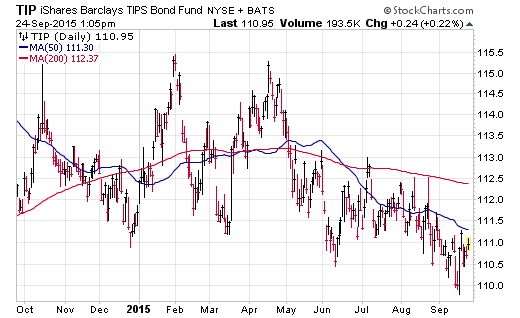Inflation is a scary word, as it generally presages effects like rising interest rates, higher costs of living, and climbing commodity prices. This has been one of the expected outcomes from the Fed’s implementation of quantitative easing during the course of the last half decade. Yet, despite their best efforts, inflation has been a non-event in the economic recovery from the 2009 lows.
Based on widely accepted measures such as the Consumer Price Index (CPI), inflation has been kept in check or steadily trending downward over the last several years. Obviously the decline in traditional commodity and agriculture prices has helped keep input costs in check, which have in turn carried forward to products and services we consume.
Another way to gauge inflation expectation is by taking the temperature of the fixed-income markets.
One of my preferred methods for this task is monitoring the price trend of the iShares TIPS ETF (TIP). This ETF has $13.5 billion dedicated to a portfolio of 39 Treasury Inflation Protected Securities. TIP has an expense ratio of 0.20% and an average duration of 7.71 years.
Most investors incorrectly assume that something with “inflation protection” in the name must mean it works well in a rising interest rate environment. However, TIPs function by readjusting their coupon payments based on the movement in CPI. Essentially they offer an insurance component that makes them attractive to own when inflation measures are on the move higher.
A look at the chart of TIP below shows how fixed-income investors perceive the likelihood of true inflationary pressures creeping up. Not only is the price of TIP trending lower, but the short and long-term moving averages are also sloping down as well.

Of course, it’s important to consider the price trend of TIP in context of the wider bond market as well. When you compare this index against a basket of traditional intermediate-term Treasury bonds, it makes the divergence even more pronounced. Below is a 1-year performance comparison between TIP and the iShares 7-10 Year Treasury Bond ETF (IEF).
















Leave A Comment